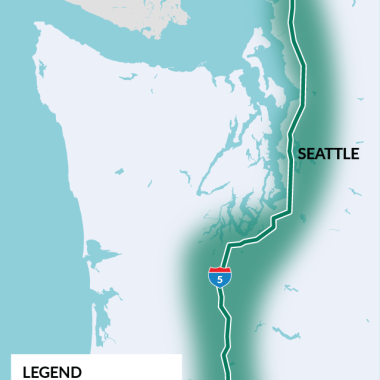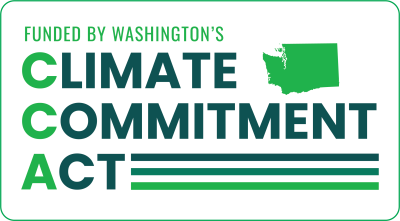Planning study news
In December 2024, WSDOT secured a federal grant agreement to advance Cascadia High-Speed Rail planning. The Federal Railroad Administration awarded WSDOT $49.7 million to develop a service development plan for Cascadia High-Speed Rail. The program will also receive $5.5 million in state match funds from the Washington State Legislature.
Purpose
Cascadia High-Speed Rail is part of WSDOT’s Cascadia High-Speed Rail and I-5 Program to address the future transportation needs of western Washington communities. The integrated Cascadia High-Speed Rail and I-5 Program allows us to look holistically at highway, rail and other travel options.
Cascadia High-Speed Rail is a unique partnership between the states of Washington and Oregon, and the province of British Columbia. WSDOT in partnership with Oregon and British Columbia are studying how high-speed rail might serve as a catalyst for a stronger, better connected economic megaregion — stretching from greater Vancouver, British Columbia to metro Seattle, Washington to Portland, Oregon. A key part of that vision is a fast, frequent, and reliable transportation system that better connects the Cascadia Megaregion, and positions it for global competitiveness and future prosperity.
2024 federal grant award and next steps
The project was awarded a $49.7 million grant from the Federal Railroad Administration in December 2024. The project also received $5.5 million in state match funds from the Washington State Legislature. These funds will support the next phase of work, including the technical work and community and partner engagement to look at market and potential ridership, route options, and service options. This marks the second FRA Corridor Identification and Development grant program award for Cascadia High-Speed Rail, now part of the federal funding pipeline for passenger rail development.
2025 status report
This report to the Legislature provides an overview on activities that occurred between July 1, 2024 and June 30, 2025 and describes the next phase of work. It is not a planning report subject to public comment.
View the 2025 UHSGT status report (PDF 838KB) submitted to the Washington State Legislature in June 2025.
Why are WSDOT and its partners studying high-speed rail?
High-speed rail has the potential to transform how we travel in the Cascadia Megaregion, providing greater travel options to move more people and goods. It is intended to seamlessly connect to and complement other travel options, including I-5, Amtrak Cascades service, existing and developing regional transit systems, and air mobility service.
High-speed rail is about more than transportation. It could result in better access to jobs, affordable housing, shared resources, increased collaboration and economic prosperity. It could strengthen the megaregion’s position in the global marketplace, supporting a robust innovation economy and greater collaboration with our neighbors.
Cascadia High-Speed Rail will leverage best practices and lessons learned from projects under development in the United States and operational systems from around the world.
What is the Cascadia Megaregion?
There are 11 growing megaregions in the United States. Megaregions are networks of cities with shared economies, infrastructure and natural ecosystems. The Cascadia megaregion is known for its fast-growing economy and population. It covers Vancouver, BC; Seattle, Washington; and Portland, Oregon.
What is happening in this current phase of the project?
With funding provided by the Corridor ID Program and the Washington State Legislature, planning over the next four years will be guided by the federal requirements for the service development plan.
In this phase of work, we will evaluate key factors that affect speeds and travel times, including route alignment, number of stations and market and ridership potential. One of the key outcomes is a range of potential route options for further analysis. Specific route alignment and station locations will be identified in a future phase.
The service development plan will also help us answer several key questions about the future service, including:
- What is the vision for a high-speed corridor given projected regional growth?
- What is the market and ridership potential?
- What environmental opportunities and concerns need to be considered?
- What are the potential route options?
- And, at a high-level, what are the economic and governance considerations for future phases?
Would high-speed rail replace Amtrak Cascades?
No. Cascadia High-Speed Rail would complement, not replace, the existing Amtrak Cascades passenger rail service. High-speed services, like the proposed Cascadia High-Speed Rail, can reach speeds between 160 and 250 miles per hour.
Because Amtrak Cascades trains currently share tracks with freight trains, additional capacity for passenger rail service is limited. High-speed rail would likely require new, dedicated tracks. High-speed rail systems make fewer stops and offer shorter trip times than conventional rail services. Passengers would use Amtrak Cascades and local transit options to reach destinations in between high-speed rail stops.


